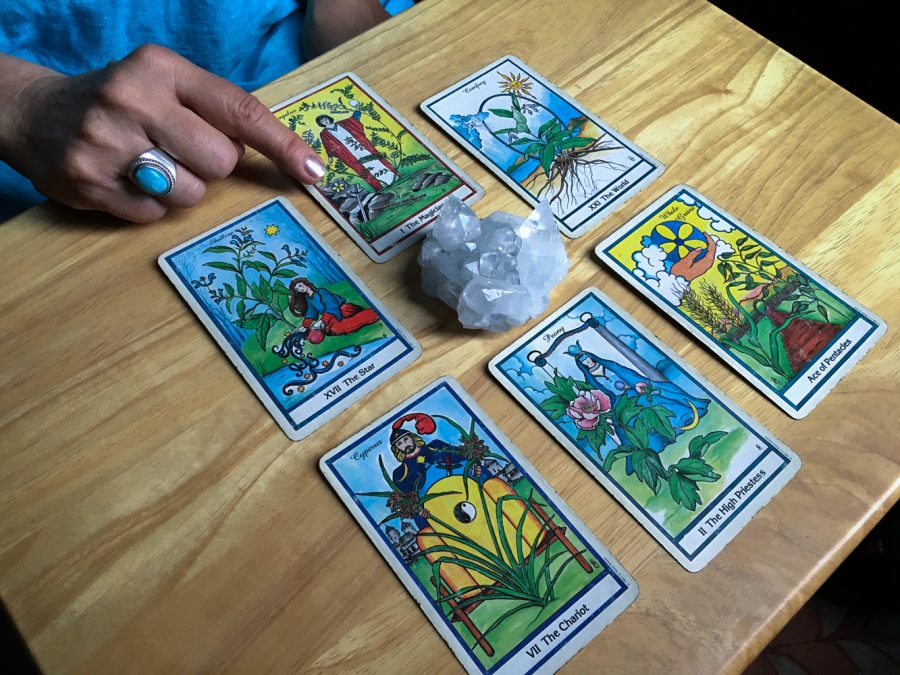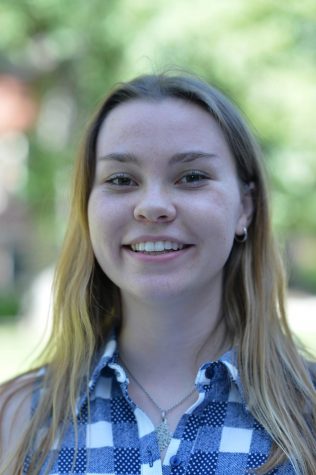Card readings can provide context, comfort
Tarot maintains poor reputation for witches, but this practice uses images to work through life problems
The cards, part of the Major Arcana in a tarot deck, can give people perspective on their lives, Linda Kingsbury of Spirit Herbs said.
October 3, 2018
For some people, the word “tarot” can conjure up images of witchy women, crystal balls or demonic power. But tarot readers on the Palouse are far from Satanic. They just want to help.
“I get a lot of people thinking tarot is the same as a Ouija board, or they’re like ‘Aren’t you talking to demons?’ ” said Kay Kall, a local tarot reader at Mirror Mirror Tarot. “No, I’m not. It’s not evil.”
For Linda Kingsbury of Spirit Herbs in Moscow, tarot is just one facet of her eclectic healing practice. She has a doctorate in nutrition, she grows and sells medicinal herbs and she practices what she calls vibrational medicines, like reiki and sound therapy.
Kingsbury said tarot addresses a primary human need for a sense of belonging.
“A reading can help to personalize how you fit in the world,” Kingsbury said. “Often our parents don’t talk about it, and sometimes people who go to a Sunday celebration aren’t fulfilled there. So there’s a yearning to understand where we belong.”
Kingsbury said the cards give people perspective because each card depicts a different aspect of life. One card’s image might represent disappointment, while another represents observing life cycles.
In a 78-card tarot deck, 22 of them count as the Major Arcana, recognized by occultists as the pictured cards of the deck. The rest fall within the Minor Arcana. The Major Arcana depict stages of life from birth to death, or from birth to fulfillment, Kingsbury said.
“What are the cultural stories that create the foundation for living?” Kingsbury said. “What’s the philosophy that is all over the world, in all of human existence? Tarot is just one of the methods that tunes into the archetypal patterns that humans go through — these stories are within us.”
Lillia Green has been studying tarot for seven years, and offers free monthly readings at Pups & Cups Cafe. She said the questions that come up in her readings usually have similar themes: careers, school, romance and health.
“I’m not a pregnancy test,” Green said. “Sometimes I will say, ‘I can tell you what the cards say, but I’m not a medical professional, I’m not a psychologist and one of those would be more suitable to your needs.’ ”
As opposed to a doctor, Kingsbury said a tarot reader’s role is similar to that of a priest or shaman. She said she believes humans have always had questions about the meaning in their lives and things that can’t be observed with five senses.
“Years ago, in villages, there was always someone that was a consultant, that had some type of connection to the world beyond the physical world — a connection to God,” Kingsbury said.
From an anthropological perspective, a tarot reader could be described as a diviner, which is a role found in many communities. Julia Cassaniti, a psychological anthropologist at WSU, said it’s important to take a worldwide perspective when thinking about divination.
“Lots of religious practices help people understand meaning, or problems that they’re having, or how to get along with people,” Cassaniti said. “So rather than saying, ‘This [tarot] is so weird’ actually, it’s not necessarily weird in a global way. It has history and connections.”
Cassaniti said even if our local tarot methods don’t obviously match historical tarot methods, they still have cultural value.
“Even if not everybody who practices something like tarot knows all those connections, they’re still practicing in ways that are situated for them,” she said.
In Pullman, tarot readers said they are working with many people who have agnostic and New Age beliefs, so they keep their mystical explanations open-ended.
“[Tarot] is more of a tool for you to speak to whoever you feel like you’re speaking to, whether it’s polytheistic, spirit guides, fairies or God,” Kall said. “I don’t like to put a whole lot of emphasis on what you call it, because it throws people off sometimes.”
Green talks in terms of intuition. She said there are two schools of thought. In one, people believe the cards hold power, and in the other, they say the cards are tools for honing a reader’s intuition.
“I lean toward the cards being a tool for intuition,” Green said.
Kingsbury said every healing practice she uses is “multicultural and interfaith.” She believes anyone of any religion can benefit from her services and interpret them in a way that makes sense to them.
For Kingsbury, the explanation that makes sense involves energy and vibration. She believes energy pulls a person to the card they need to see.
“Since everything in life is vibration, your vibration will be attracted, like a magnetic energy, to what’s meaningful to you,” she said. “The benefit of the cards, and the whole idea behind any vibrational medicine, is to tune into your soul so you can make the best of your time and your focus and your energy.”
Intention is an important concept to all three tarot readers. Kingsbury said the first step is finding the right question. Kall agreed.
“One hundred percent, definitely the clarity of the question is what makes a reading accurate,” Kall said. “If my verification cards don’t work out, maybe I’m not asking the right question.”
For those who have a question to ask a tarot reader, they will find a variation in their rates. Lillia Green offers free readings at Pups & Cups on the second Sunday of every month. Kaly Kall of Mirror Mirror Tarot charges $5 or less for a simple three-card reading, or $15 for a 30-minute session.
For an hour-long session, Kingsbury charges $150. She also offers weekly kundalini yoga classes at Kula Yoga & Tea in Moscow.
This article has been updated to reflect Kay Kall’s correct name.










